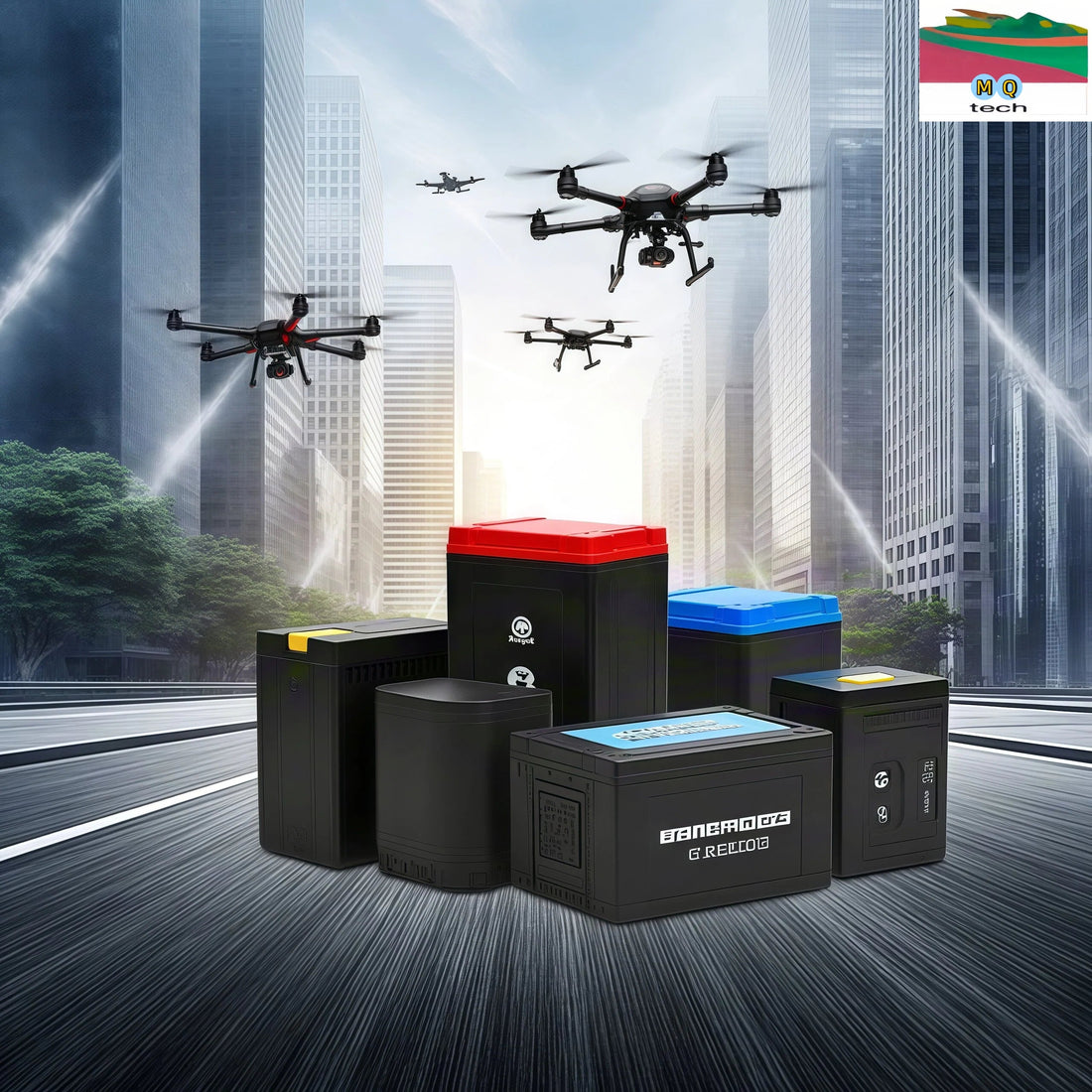Drone Batteries: Classifications and Applications
The battery is the lifeblood of any uncrewed aerial vehicle (UAV), determining its flight time, performance, and overall capabilities. Selecting the right type of battery is crucial for optimizing a drone's operation for specific tasks. Below is a detailed guide to the primary types of drone batteries and their ideal applications.
1. Lithium Polymer (LiPo) Batteries
Classification: High-Performance, Lightweight
Overview:
LiPo batteries are the most common choice for consumer-grade and professional racing/filming drones. They use a polymer electrolyte instead of a liquid one, allowing for a flexible, lightweight, and compact pouch design. They are renowned for their high discharge rates, which provide the immense power needed for aggressive maneuvers.
Key Characteristics:
-
High Energy Density: Offers a good balance of weight and capacity.
-
High Discharge Rate (C-Rating): Capable of releasing energy very quickly for high-speed flight.
-
Lightweight and Pliable: Can be shaped to fit a drone's frame efficiently.
-
Requires Careful Handling: They are volatile, can swell, and are susceptible to fire if damaged, over-charged, or over-discharged.
Ideal Applications:
-
Aerial Photography & Videography: (e.g., DJI Drones) Provides stable, reliable power for smooth camera operation.
-
FPV & Drone Racing: Requires the high burst power for rapid acceleration and sharp turns.
-
Recreational Hobby Drones: The standard for most off-the-shelf models.
2. Lithium-Ion (Li-ion) Batteries
Classification: High-Capacity, Long-Endurance
Overview:
Li-ion batteries prioritize energy capacity over power discharge. They have a higher energy density than LiPos, meaning they can store more energy for the same weight, but they have a much lower discharge rate. This makes them unsuitable for high-speed flight but excellent for prolonged, steady missions.
Key Characteristics:
-
Highest Energy Density: Provides the longest flight times available in a chemical battery.
-
Low Self-Discharge Rate: Holds its charge longer when not in use.
-
Lower Discharge Rate: Not suitable for high-power applications.
-
Rigid Cylindrical Cell Design: Typically found in 18650 or 21700 formats.
Ideal Applications:
-
Mapping & Surveying: Long flight times allow for covering large areas in a single flight.
-
Industrial Inspection: (e.g., power lines, pipelines, solar farms) Enables extended loitering time for detailed data collection.
-
Long-Range Fixed-Wing Drones: Essential for drones designed to cover vast distances.
3. Hydrogen Fuel Cells
Classification: Next-Generation, Extended Endurance
Overview:
This is an emerging technology that generates electricity through a chemical reaction between hydrogen and oxygen, with water and heat as the only byproducts. It is not a "battery" in the traditional sense but an energy generator.
Key Characteristics:
-
Extremely Long Endurance: Can provide flight times many times longer than LiPo or Li-ion batteries (e.g., 3+ hours).
-
Rapid Refueling: Unlike batteries that require hours to recharge, hydrogen tanks can be refilled in minutes.
-
High Cost & Complexity: The system involves the fuel cell stack, lightweight hydrogen tanks, and supporting systems.
-
Clean Emissions: Only emits pure water vapor.
Ideal Applications:
-
Heavy-Lift Logistics: (e.g., MQtech1-qn100) For delivering heavy payloads like medical supplies or spare parts over long distances.
-
Long-Duration Missions: Persistent surveillance, emergency response, and large-scale agricultural monitoring.
-
BVLOS (Beyond Visual Line of Sight) Operations: Ideal for missions where long range and endurance are critical.
4. Nickel-Based and Other Batteries
Classification: Legacy, Niche Use
Overview:
This category includes older technologies like Nickel-Cadmium (NiCd) and Nickel-Metal Hydride (NiMH). They are heavier, have lower energy density, and suffer from "memory effect" (in the case of NiCd). They are largely obsolete for modern drones but may be found in some very old or specialized industrial models.
Key Characteristics:
-
Durable and Tolerant: Can withstand abuse and a wide temperature range.
-
Heavy and Low Capacity: Poor weight-to-power ratio.
-
Memory Effect: (NiCd) Capacity reduces if not fully discharged before recharging.
Ideal Applications:
-
Legacy drone systems.
-
Specific industrial applications where their unique tolerance is required.
Summary Table
| Battery Type | Key Advantage | Key Disadvantage | Best For |
|---|---|---|---|
| Lithium Polymer (LiPo) | High Power & Discharge Rate | Requires careful handling & maintenance | Racing, Filming, Hobby |
| Lithium-Ion (Li-ion) | High Capacity & Long Endurance | Lower discharge rate, not for high speed | Mapping, Inspection, Surveying |
| Hydrogen Fuel Cell | Ultra-Long Endurance & Fast Refuel | High cost & system complexity | Logistics, Long-duration BVLOS |
| Nickel-Based (NiCd/NiMH) | Durability & Tolerance | Heavy, low energy density, memory effect | Legacy & Niche Systems |
In conclusion, the choice of a drone battery is a direct trade-off between power, weight, endurance, and cost. Understanding these classifications and their ideal use cases is fundamental to selecting the right power source for a successful drone operation.
---------------
#Drone Batteries
#UAV Batteries
#Quadcopter Batteries
#Drone LiPo Batteries
#Drone Lithium Polymer
#Drone Battery Pack
#Drone Power System
#Drone Flight Battery
#Intelligent Drone Battery
#High Voltage Drone Battery
#Drone Battery Charger
#Drone Battery Management System
#Drone BMS
#Drone Battery Controller
#Smart Drone Battery
#Drone Battery Capacity
#Drone Battery Voltage
#Drone Battery Connector
#XT60 Drone Battery
#EC5 Drone Battery
#Drone Battery Charging
#Drone Battery Discharging
#Drone Battery Storage
#Drone Battery Safety
#Drone Battery Explosion
#Drone Battery Fire
#Drone Battery Maintenance
#Drone Battery Care
#Drone Battery Life
#Drone Battery Cycle Life
#Drone Battery Warranty
#FPV Drone Battery
#Racing Drone Battery
#Cinematic Drone Battery
#Professional Drone Battery
#Consumer Drone Battery
#Industrial Drone Battery
#Commercial Drone Battery
#Agricultural Drone Battery
#Delivery Drone Battery
#Mapping Drone Battery
#Surveying Drone Battery
#Photography Drone Battery
#Videography Drone Battery
#DJI Drone Battery
#DJI Mavic Battery
#DJI Phantom Battery
#DJI Inspire Battery
#DJI Air Battery
#DJI Mini Battery
#Autel Drone Battery
#Parrot Drone Battery
#Yuneec Drone Battery
#Drone Battery Specifications
#Drone Battery Parameters
#Drone Battery Performance
#Drone Battery Runtime
#Drone Battery Flight Time
#Drone Battery Endurance
#Drone Battery Weight
#Drone Battery Size
#Drone Battery Dimensions
#Drone Battery Chemistry
#LiPo Battery
#Li-ion Battery
#LiFePO4 Drone Battery
#High Capacity Drone Battery
#Long Range Drone Battery
#Heavy Lift Drone Battery
#Drone Battery Price
#Drone Battery Cost
#Drone Battery Replacement
#Drone Battery Upgrade
#Drone Battery Compatibility
#Drone Battery Model
#Drone Battery Part Number
#Original Drone Battery
#Aftermarket Drone Battery
#Third Party Drone Battery
#Compatible Drone Battery
#Drone Battery Manufacturing
#Drone Battery Factory
#Drone Battery Supplier
#Drone Battery Wholesale
#Drone Battery Retail
#Drone Battery Shipping
#Drone Battery Certification
#UL Certified Drone Battery
#CE Certified Drone Battery
#FCC Certified Drone Battery
#Drone Battery Transportation
#Drone Battery Air Shipping
#Drone Battery IATA
#Drone Battery UN38.3
#Drone Battery Testing
#Drone Battery Quality Control
#Drone Battery QC
#Drone Battery Standards
#Drone Battery Safety Standards
#Drone Battery Protection
#Overcharge Protection
#Over-discharge Protection
#Short Circuit Protection
#Overcurrent Protection
#Temperature Protection
#Balance Charging
#Cell Balancing
#Drone Battery Storage Voltage
#Drone Battery Storage Charge
#Drone Battery Discharge Rate
#C Rating
#Discharge Current
#Continuous Discharge
#Peak Discharge
#Drone Battery Charging Rate
#Charging Current
#Charging Time
#Fast Charging
#Quick Charging
#Parallel Charging
#Series Charging
#Drone Battery Charging Station
#Drone Battery Charging Hub
#Drone Battery Charging Board
#Drone Battery Charging Safety
#Drone Battery Bag
#Drone Battery Case
#Drone Battery Storage Bag
#Fireproof Drone Battery Bag
#Drone Battery Explosion Proof
#Drone Battery Disposal
#Drone Battery Recycling
#Drone Battery Environment
#Drone Battery Temperature
#Cold Weather Drone Battery
#Winter Drone Battery
#Hot Weather Drone Battery
#Summer Drone Battery
#Drone Battery Heating
#Drone Battery Insulation
#Drone Battery Preheating
#Drone Battery Technology
#Drone Battery Innovation
#Drone Battery Research
#Drone Battery Development
#Next Generation Drone Battery
#Future Drone Battery
#Solid State Drone Battery
#Graphene Drone Battery
#Nanotechnology Drone Battery
#AI Drone Battery
#Smart Battery Technology
#Wireless Drone Battery
#Drone Battery Monitoring
#Drone Battery Telemetry
#Drone Battery Voltage Monitoring
#Drone Battery Current Monitoring
#Drone Battery Temperature Monitoring
#Drone Battery Health Monitoring
#Drone Battery App
#Drone Battery Software
#Drone Battery Firmware
#Drone Battery Update
#Drone Battery Calibration
#Drone Battery Reset
#Drone Battery Error Codes
#Drone Battery Troubleshooting
#Drone Battery Problems
#Drone Battery Issues
#Drone Battery Swelling
#Drone Battery Puffing
#Drone Battery Damage
#Drone Battery Repair
#Drone Battery Service
#Drone Battery Support
#Drone Battery Guide
#Drone Battery Tutorial
#Drone Battery Tips
#Drone Battery Best Practices
#Drone Battery FAQ
#Drone Battery Questions
#Drone Battery Forum
#Drone Battery Community
#Drone Battery Reviews
#Drone Battery Ratings
#Drone Battery Test
#Drone Battery Comparison
#Drone Battery Buyers Guide
#Drone Battery Shopping
#Drone Battery Deals
#Drone Battery Discount
#Drone Battery Sale
#Drone Battery Promotion
#Drone Battery Coupon
#Drone Battery Black Friday
#Drone Battery Cyber Monday
#Drone Battery Prime Day

